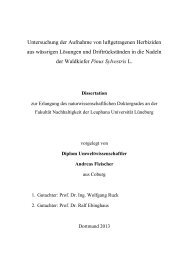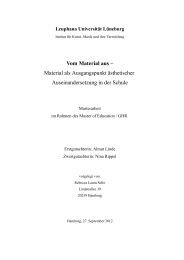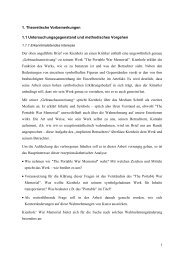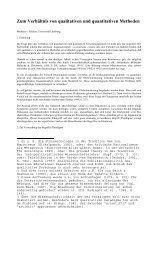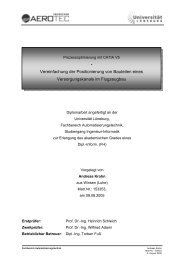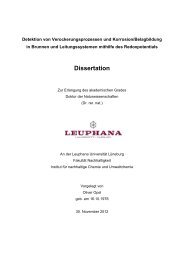Determinants of Emotional Experiences in Traffic Situations ... - OPUS
Determinants of Emotional Experiences in Traffic Situations ... - OPUS
Determinants of Emotional Experiences in Traffic Situations ... - OPUS
You also want an ePaper? Increase the reach of your titles
YUMPU automatically turns print PDFs into web optimized ePapers that Google loves.
<strong>Emotional</strong> States <strong>of</strong> Drivers and Their Impact on Driv<strong>in</strong>g Behaviour 79<br />
Goal Block<strong>in</strong>g <strong>Situations</strong>!<br />
Goal Promot<strong>in</strong>g <strong>Situations</strong>!<br />
Arrival!<br />
Security!<br />
1! 2!<br />
Slow car<br />
(long distance)!<br />
Construction<br />
site!<br />
(long wat<strong>in</strong>g<br />
time)!<br />
3! 4!<br />
Brak<strong>in</strong>g Car!<br />
Obstacle (on the<br />
(dangerous<br />
street)!<br />
brak<strong>in</strong>g)!<br />
1! 2!<br />
Slow car (short<br />
distance)!<br />
Construction<br />
site!<br />
(no wait<strong>in</strong>g<br />
time)!<br />
3! 4!<br />
Brak<strong>in</strong>g Car!<br />
Obstacle (next<br />
(no dangerous<br />
to the street)!<br />
brak<strong>in</strong>g)!<br />
With<strong>in</strong>-<br />
Subject!<br />
Person!<br />
Situation!<br />
Person!<br />
Situation!<br />
Beween-Subject!<br />
Figure 1: Mapp<strong>in</strong>g <strong>of</strong> the situations on appraisal theory factors<br />
3.2.4 Design<br />
The experimental design consisted <strong>of</strong> the three <strong>in</strong>dependent situational factors, which <strong>in</strong>fluenced how<br />
the participants appraised the situation. The experiment was a 2x2x2 mixed-design, consist<strong>in</strong>g <strong>of</strong> eight<br />
different traffic scenarios: the 2x2 with<strong>in</strong>-subject factors were goal relevance (arrival vs. safety) and<br />
other-accountability (personal blame vs. situational blame). The goal congruency factor varied<br />
between subjects, so that each participant had either four goal congruent scenarios or four goal<br />
<strong>in</strong>congruent scenarios dur<strong>in</strong>g their experimental drive. The emotions experienced were compared to<br />
the driv<strong>in</strong>g behaviour.<br />
3.2.5 Experimental Measures<br />
The driver was questioned about his/her emotion after the drive <strong>in</strong> order not to <strong>in</strong>terrupt the participant<br />
and to prevent potential behavioural cues, therefore, four pictures <strong>of</strong> the critical sections <strong>of</strong> the<br />
experimental drive were provided. Every situation was rated us<strong>in</strong>g an <strong>in</strong>ternally revised edition <strong>of</strong> the<br />
Geneva Emotion Wheel (Oehl, Roidl, Frehse, Suhr, Siebert et al., 2010; Scherer, 2005), cover<strong>in</strong>g 16<br />
emotions suitable for the driv<strong>in</strong>g context. This edition was derived from the orig<strong>in</strong>al wheel, which<br />
spatial structure was confirmed <strong>in</strong> English and French language (Bänziger, Tran & Scherer, 2005).<br />
Back-and-forth translation and the exchange <strong>of</strong> emotional qualities (disgust, elation, envy and pleasure<br />
were removed, amusement, happ<strong>in</strong>ess, fright and feel<strong>in</strong>g helpless were added) made the tool more<br />
suitable for traffic sett<strong>in</strong>gs (Roidl, Frehse, Oehl & Höger, 2013). The participants were allowed to rate<br />
up to three different emotions with<strong>in</strong> each critical situation on a Likert-scale rang<strong>in</strong>g from 1 (weak<br />
emotion) to 5 (very strong emotion). The emotions were later analysed and compared with the specific<br />
driv<strong>in</strong>g behaviours displayed dur<strong>in</strong>g the four critical situations. To <strong>in</strong>vestigate the <strong>in</strong>fluence <strong>of</strong><br />
<strong>in</strong>dividual factors, trait driv<strong>in</strong>g anger was measured with a German version <strong>of</strong> the Driv<strong>in</strong>g Anger Scale<br />
(DAS; Deffenbacher et al., 1994; Steffgen, Recchia & Ludewig, 2008). It <strong>in</strong>cludes 33 items which<br />
!



